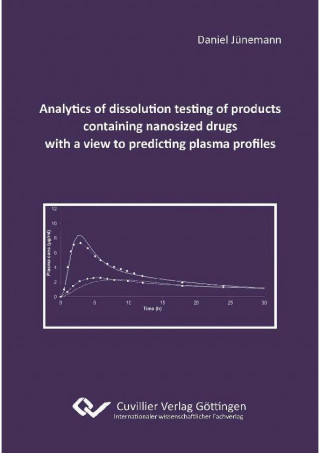
Delivery
Shopping guide





Doesn't suit? No problem! You can return within 30 days
 Gift voucher
any value
Gift voucher
any value
You won't go wrong with a gift voucher. The gift recipient can choose anything from our offer.
Analytics of dissolution testing of products containing nanosized drugs with a view to predicting plasma profiles
 English
English
 71 b
71 b
30-day return policy
You might also be interested in


The oral bioavailability of a drug substance is strongly related to its aqueous solubility.Only complete dissolution during the GI-passage can maintain an optimalbioavailability. Poor aqueous drug solubility results, according to the Nernst-Brunnerequation into a slow dissolution rate, sometimes too slow for complete dissolution inthe GI tract. The dissolution rate increases with decreasing particle size and thereforeincreasing surface area of the drug particles. In consequence,, micronization of thedrug is applied to increase oral bioavailability, but often meets with modest success.Recently developed techniques were applied to decrease the particle size into thenanometer range. For some substances, pharmacokinetic parameters could beinfluenced decisively, e.g. the obviation of a food effect for the drugs aprepitant andfenofibrate.The assessment of a dosage form is investigated by dissolution testing. For areasonable assessment of such tests, a separation of solid and liquids has to beensured within an appropriate time frame. For particle sizes of about 150 nm itappears questionable whether such separation can be succeeded by classicaltechniques, e.g. the use of syringe filters with a pore size of 0.45 µm.The aims of this thesis were to investigate the suitability of various analyticaltechniques in analysis of dissolution tests containing nanosized drug substance.Furthermore, a suitable analytical tool is applied to establish an in vitro - in vivocorrelation of the nanosized drug fenofibrate.At first, several techniques were investigated in theory to assess their ability to ensurea rapid and complete separation of solids and liquids. The classical dialysis, turbiditymeasurement and UV-measurement via fiber optics were excluded from furtherinvestigation due to various reasons, e.g. the speed of separation for dyialisis. Theasymmetrical flow field-flow fractionation appeared to be a promising tool, but lack ofequipment precluded further investigation.The ultrasonic resonance technology (ResoScan), the microdialysis and the use ofcentrifugal filter devices have shown to be inappropriate for the analytics of nanosizeddrugs in dissolution test. The use of syringe filters with various pore sizes and the ionselectiveelectrode (ISE) was promising, so these techniques were examined moreintensively.The syringe filters with various filter pore sizes were investigated for their ability tohold back colloidal drug. Fenofibrate was chosen as model drug, since this iscommercially available both as micronized and nanosized formulation (Lipidil TerR andLipidil 145 ONER), enabling direct comparison.The experiments with micronized fenofibrate which contains little or no colloidalfenofibrate yielded similar dissolution profiles, irrespective of filter pore size; f2 wasalways greater than 65, indicating less than 5% difference between the dissolutionprofiles in any medium.Using a pore size of 0.1 µm or less, the maximum concentration of drug achieved insolution from the nanosized formulation was commensurate with the saturationsolubility of fenofibrate in all tested media. Filtration with a pore size of 0.2 µm or 0.45µm generated concentrations exceeding the saturation solubility. These results, incombination with higher standard deviations of the analytical results, indicate that theapparent "supersaturationż is caused by colloidal fenofibrate, which is too fine to beheld back by these filters. The f2-value of less than 50 when comparing the profilesobtained from 0.1 µm and 0.2 µm filter pore size indicates that the choice of filter poresize is crucial to the interpretation of the dissolution profiles. To separate nanosizeddrug from molecularly dissolved fenofibrate in Lipidil 145 ONER, a filter pore size of 0.1µm or less appears to be appropriate.It was observed that the experimental increase of dissolution rate is not congruentwith common hypothesis regarding the boundary layer h for decreasing particle sizesand subsequent application of the Nernst-Brunner equation.The initial dissolution rates of both formulations were investigated by using a filterpore size of 0.1 µm. The results were utilized in an in silico model (STELLAc) tocorrelate the in vitro results with in vivo data (Model A). In the preprandial state a goodin correlation was established for the micronized fenofibrate, while for the nanosizedfenofibrate the plasma levels were overpredicted.The model was expanded to investigate the impact of an absorption step at theintestinal membrane on the in vitro - in vivo correlation. It was found that even aminor deceleration of absorption results in varied plasma profiles caused by a laggedappearance of drug in the blood.For both formulations the rate determining step was identified: When changing fromthe micronized to the nanosized formulation, the rate-determining step for absorptionmay change from completely dissolution-controlled to at least partly permeationcontrolledin the fasted state.In the fed state, gastric emptying appears to be rate-determining for absorption offenofibrate from both the micronized and the nanosized formulation.Another technique appears to be suitable for analysis of nanosized drugs in dissolutiontesting. The Ion-selective electrode (ISE) is a recently developed analytical systemmeasuring the changes of the electrochemical potential in solutions. A transformationvia the Nikolski - Eisenmann equation results into the concentration of the respectivedrug in solution. Since only dissolved drug is detected, obviating the need forseparation of dissolved from undissolved drug, this system appears to be verypromising in the analytics of nanocrystalline drugs.Diphenhydramine_HCl was chosen as model substance for the ISE studies. It was thegoal of investigation to test compatibility of the ISE with complex media, e.g. allbiorelevant dissolution media. This is done in advance of application of the ISE in thesemedia for nanocrystalline drug substance. The results were compared to manualsampling, filtration and subsequent HPLC-UV analysis.The results demonstrate that the ion-selective electrode is suitable for measurementsof diphenhydramine HCl in fasted state biorelevant media (FaSSGF, FaSSIF, FaSSIF-V2)as both a stand-alone system (Method A) and in conjunction with a single pointconventional assay (Method B). The results acquired are similar to those obtained bymanual sampling and subsequent HPLC-UV analysis. The ISE also delivers satisfactoryresults in a milk-based medium (FeSSGF), in which it has distinct advantages overmanual sampling with HPLC-UV analysis by obviating the need for sample preparation.The application of the ISE in FeSSIF type media will need further study.Finally, as an on-line technology, ISE offers more efficient generation of dissolutionprofiles than conventional sample-based methods.
About the book
 English
English




 How to shop
How to shop






















